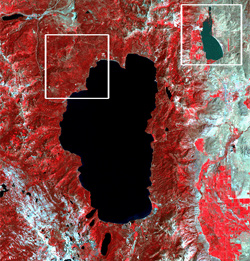Climate change reducing Lake Tahoe’s water clarity
Climate change reducing Lake Tahoe’s water clarity
mongabay.com
August 16, 2007
Lake Tahoe in Northern California is losing is characteristic water clarity due to pollution and climate change, reports a new study by the University of California at Davis.
According to the report, night low temperatures have risen more than 4 degrees F since 1911 while the number of days with average air temperatures below freezing has dropped from 79 days to 52 days since that time. Less precipitation is falling as snow while lake temperatures are rising: the average July surface water temperature has increased almost five degrees, from 62.9 degrees F. to 67.8 degrees F., since 1999. The lake’s surface waters were the warmest on record on July 26, 2006: 78 degrees F.
The changes are leading to deterioration of the lake’s famous water clarity, which has fallen from an average depth of 102.4 feet in 1968 to 67.7 feet today.
“Higher precipitation results in more runoff and affects the amount of soil particles and pollutants that are washed into the lake,” said John Reuter, the associate director of the UC Davis Tahoe Environmental Research Center.

Satellite image of Lake Tahoe. U.S. Geological Survey |
Increased runoff, combined with warmer lake temperatures, also fuel the growth of algae, which absorbs light and further reduces water clarity.
Higher temperatures are causing ecological changes as well.
“The persistent increase in water temperature that we have observed since 1978 is beginning to have noticeable impacts on the entire Lake Tahoe ecosystem,” said Geoff Schladow, an expert on lake health and director of the UC Davis Tahoe Environmental Research Center.
“The types of algae we see in the lake are changing, and they are starting to be present earlier in the year. The lake is becoming more hospitable to invasive plants and fish, with warm-water species like bass and carp increasingly common.”
Still the UC Davis scientists are hopeful that conditions can be improved.
“We remain committed to turning the tide on the long-term trend of declining clarity at Lake Tahoe and we must sustain our investment in environmental improvements if we want to achieve this important goal for future generations,” said Julie Regan, communications and legislative affairs chief at the Tahoe Regional Planning Agency.
“Tahoe: State of the Lake Report 2007” provides a summary of tens of thousands of scientific observations of lake weather, water conditions, and aquatic life made since the late 1960s by UC Davis scientists. Some of the data dates back as far as 1911.
terc.ucdavis.edu
U.S. Geological Survey